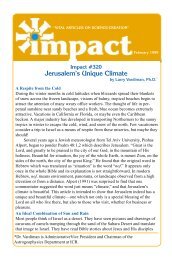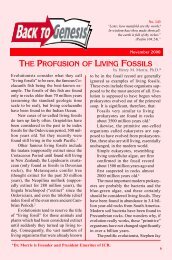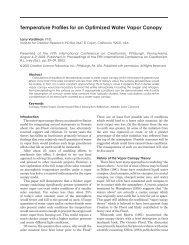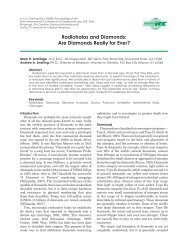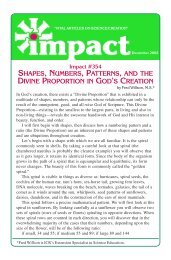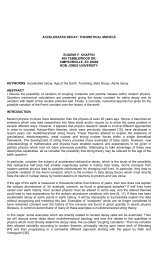Download September 2008 PDF - The Institute for Creation Research
Download September 2008 PDF - The Institute for Creation Research
Download September 2008 PDF - The Institute for Creation Research
You also want an ePaper? Increase the reach of your titles
YUMPU automatically turns print PDFs into web optimized ePapers that Google loves.
BACK TO GENESIS<strong>The</strong> increasing amount of research at the cellular level has bodedill <strong>for</strong> the naturalist who insists that life must be interpreted(strained?) through a Darwinian explanatory filter. For instance,recent studies have focused on ion channels, which arepassages designed to transport charged atoms (ions) through a membrane<strong>for</strong>med by a specific protein or proteins on the surface of cells. Energy (adenosinetriphosphate, or ATP) is not required; instead, passive transport isutilized in this very complex gating process. In 2006, researchers discusseda unique bacterial voltage-gated potassium ion (Kv) channel from thegenus Listeria. <strong>The</strong>y stated, “<strong>The</strong>fundamental principles underlyingvoltage sensing, a hallmark featureof electrically excitable cells, arestill enigmatic and the subject ofintense scrutiny and controversy.” 1After dismissing a Creator,evolutionists are in the frustratingposition of having to argue the“enigmatic” fundamental principlesof these uniquely designedprocesses. Such detailed organization,however, is not surprisingto creationists, whomaintain that if it is alive, it’scomplex. 2EvolutionContinues to Be aHard CellEarlier, Rockefeller Universityresearchers proclaimed, “Voltage-dependentchannel structurereveals masterpiece responsible <strong>for</strong>all nerve, muscle activity.” 3 “Masterpiece”is clearly the right word<strong>for</strong> this delicate voltage-regulatedpore in the plasma (cell) membranethat attracts and transmits potassium ions. <strong>The</strong> pore maintains anelectrical potential with specifications of per<strong>for</strong>mance that are superiorto man-made transistors (compact electronic devices designed to controlcurrent flow). Around the periphery of the pore and channel are foundfour protein structures (“paddles”) that are charge-sensitive, permittingthe correct ions through, but also closing to adjust the proper voltage. Afeedback loop (a biological control mechanism) is sensitive to changingconditions in the environment and maintains the proper charge.Delving into the interior of the cell, tiny protein machinescontinue to be discovered that defy “natural” explanations. Stan<strong>for</strong>dUniversity recently reported on a molecular folding machine that belongsto a general class called chaperonins and is composed of a tubewith a complex lid on each end. 4 This amazing structure, called TRiC,was discovered in the cell in 1992 and is winsomely seen by some as aFRANK SHERWIN, M.A.dressing room—an area where prying eyes cannot observe.But there’s nothing simple about TRiC. Even the lids operate morelike the iris of a camera and must open and close precisely—and <strong>for</strong> theexact amount of time—in order <strong>for</strong> the sophisticated folding operation tobe successful. About one out of every ten unfolded polypeptides requiresthis designed nanostructure. <strong>The</strong> unfinished protein is brought briefly insideTRiC, where <strong>for</strong>ces work on rapidly folding the raw protein in waysthat are currently unknown. This could be seen as the magician’s rabbitin-the-hattrick, but is clearly more mysterious, mind-boggling, and molecular(tiny)! TRiC discoverer JudithFrydman, an associate professor ofbiology at Stan<strong>for</strong>d University, saidin a classic understatement, “It is avery complex mechanism.” 4What is the evolutionary explanation<strong>for</strong> all this? <strong>The</strong> relevanceof Darwinian philosophy is beingeclipsed as a superior designbasedinference takes its place.Like secular investigators, creationscientists revel in cellularresearch, but ascribe such complexityto a Person—not a process.Our increasing understandingof the micro machinery of ourcells in this 21st century is completelynegating the traditional evolutionaryportrayal of life developingthrough chance, time, andnatural processes. Whetherthey concern bacteria orpeople, recent amazing discoveriesof micro-structuresand intricate processes at the cellularlevel really do show that “the invisible things of him from the creation ofthe world are clearly seen” (Romans 1:20).References1. Santos, J.S. et al. 2006. Molecular Template <strong>for</strong> a Voltage Sensor in a Novel K + Channel. I. Identificationand Functional Characterization of KvLm, a Voltage-gated K + Channel from Listeriamonocytogenes. Journal of General Physiology. 128 (3): 283-292.2. Sherwin, F. 2001. Just How Simple Are Bacteria? Acts & Facts. 30 (20).3. MacKinnon lab’s newest picture tells action potential story.Rockefeller University News Release, April 30, 2003. See alsoSigworth, F. 2003. Structural biology: Life’s transistors. Nature.423 (6935): 21-22.4. <strong>Research</strong>ers reveal insights into hidden world of protein folding.Stan<strong>for</strong>d University News Release. Posted on Stan<strong>for</strong>d.edu June 11, <strong>2008</strong>. See also Meyer, A. S. et al. 2003. Closing theFolding Chamber of the Eukaryotic Chaperonin Requires theTransition State of ATP Hydrolysis. Cell. 113 (3): 369-381.Mr. Sherwin is Senior Science Lecturer.14 ACTS&FACTS • SEPTEMBER <strong>2008</strong>



